
by
Paul Broussard
, posted 3 hours ago / 324 Views
The original Ghostrunner was my favorite game of 2020. Outside of filling the dystopian futuristic setting-sized hole in my heart left by Cyberpunk 2077, it was a fast-paced, no nonsense platformer/slasher with tight controls and tons of replayability. It was the game that made me a believer in first person platformers, and after it sold surprisingly well for an indie title, a sequel was greenlit relatively quickly. And, before getting into the main text of this review, can I just say how nice it is to finally be a fan of a series that doesn’t have to wait like five plus years between releases? It’s nice to know that another 10% or so of the remainder of my life won’t have to pass by before I get the chance to play a new installment in this series. One of the perks of it being an indie series without the need for massively overinflated budgets devoted to graphics.
Soapbox aside, Ghostrunner II takes place a year after the events of the first title. Our main character, Jack, somehow survived the whole ‘sacrificing himself for the sake of humanity’ bit from the previous entry (and no, the sequel isn’t particularly interested in elaborating on how), and is now working as a sort of supersoldier for the new government. One day during his normal patrols, a terrorist attack occurs, led by some very scary looking dudes, and it’s up to Jack to slice and dice his way to stop them.
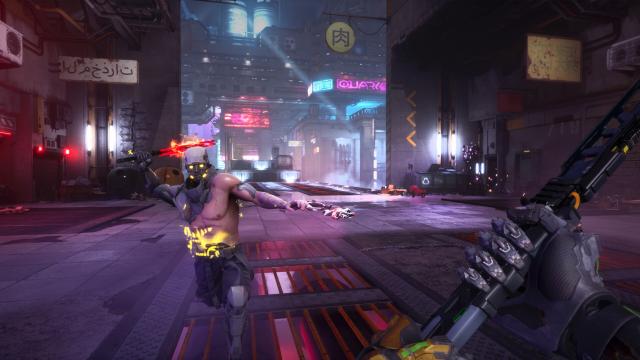
At first glance, Ghostrunner II might just seem like more of the first title, but with a shinier coat of paint. And, in many ways, it is; you progress through mostly linear missions, swapping between platforming/parkouring around the environment and engaging in combat segments. The parkour elements are fairly similar to last time around too, requiring you to wall run, grapple, dash, and make use of other elements at your disposal to navigate the environment. Many of the same puzzle elements, like having to activate time sensitive switches and move through gates before they close, also return, although they remain fairly simple.
Most of the same general rules for combat carry over as well. You and all regular enemies die in one hit, so charging wildly into battle is asking for a quick death. As before, arenas are generally pretty open and invite differing strategies for taking out the most troublesome enemies first. Once you’re in the mix, however, it’s non-stop movement, with you having to quickly jump from wall to wall and parry enemies in order to remain alive.
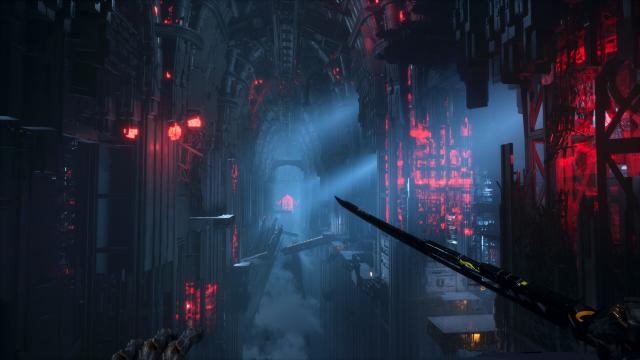
What has changed this time around is that you have a few more tricks up your sleeve. The shuriken, which was a limited use environmental pick-up last time around, is now a permanent part of your toolkit, and it’s frankly kind of amazing what such a small change does to open up your options. It works on a cooldown in battle, which keeps it from becoming too overpowered, but having it always available brings an additional layer of strategy to proceedings. There are a few other new/revamped tools as well, including the ability to turn invisible, or the altered Tempest ability that’s now a less powerful force push skill, but the shuriken was by far my favorite and kept me coming back.
Some other elements are also adjusted to tip the scales in the player’s favor. You can now block just by holding down the right mouse button (or LB on a controller), and being able to simply block rather than parry removes some of the stress from proceedings. The timing for perfect parries seems a little more generous too, although perhaps all that time playing Neon White last year just improved my reflexes. Checkpoints seem a bit more generous as well; with a few exceptions, the very long battle sequences that required near perfection in the first game are gone, so players who were turned off by that title’s high difficulty may find this installment more enjoyable.
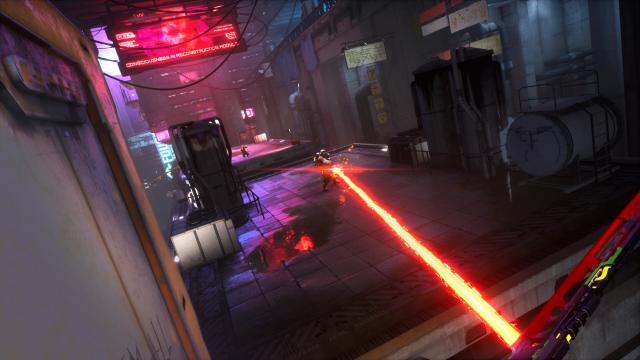
There’s a bevy of new enemy types, with most of them being pretty well-designed and enjoyable to fight. Old enemies are reused in creative new ways too, with the shuriken again playing a really fun role here as it lets you repurpose some tougher baddies as grapple points. Bosses are an upgrade from the original title, with the second boss in particular being an incredibly clever and well-designed encounter that incorporates the series’ platforming into a fight exceptionally well, while still having some combat elements.
Other general improvements include how Ghostrunner II handles its “cybervoid” sections. The first Ghostrunner decided, for some God-forsaken reason, to occasionally toss the player into very slow-paced virtual reality segments, where you either had to complete simple platforming sequences without most of your abilities or just listen to lore dumps. And while you do occasionally still get dumped into that virtual reality space, it’s much-improved, as your entire toolkit is available and there are far more interesting challenges on the table.
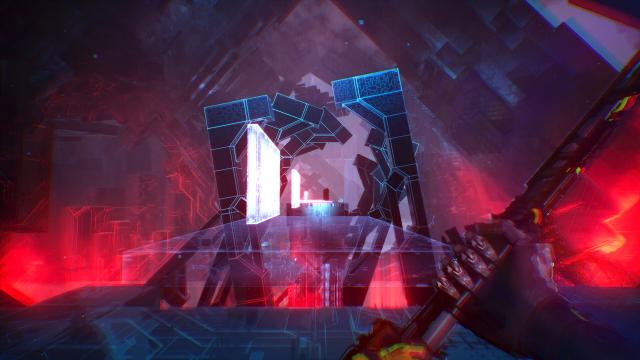
All of this sets up Ghostrunner II to not just be a solid improvement on its predecessor, but one of the best games I’ve ever played. And it is… for about four hours. That’s when we get introduced to the motorcycle, which was one of this sequel’s biggest selling points in pre-release material. In fairness, the motorcycle is a great concept in theory, and it gets an absolutely spectacular introduction via a fantastic action setpiece where you race down the exterior of Dharma Tower at breakneck pace, dodging obstacles and shooting enemies. If the bike had just been used in this regard – featured in occasional setpieces as a way to break up the core gameplay – it probably would have been a very welcome addition, because it’s frankly a ton of fun at that point.
The problem is that the gameplay starts to shift to make the motorcycle work, with the game transitioning to a semi open-world level design after the halfway point or so, and it gets pretty boring, unfortunately. There’s a lot of riding on empty roads, boosting off ramps to reach new areas, and then parking your bike every few minutes to look around for a switch to open a gate so you can keep driving through. This section is highlighted by a roughly hour-long mission that primarily involves driving to three towers around the area. It’s dull, uninspired, and frankly something I can’t see myself ever returning to, which is about as bad a thing as you can say for a series that sells itself on replayability as much as Ghostrunner does.
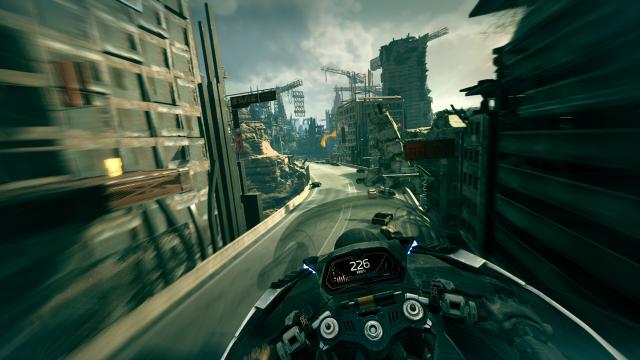
Fortunately the bike only sticks around for about a quarter of the runtime, and we get to go back to the standard Ghostrunner II gameplay after that. There are a couple of highlight bosses to close things off and some of the title’s best, most satisfying segments are saved for last. This, frankly, just made that quarter of the game stick out even more; it’s a glaring sore spot in the midst of what would otherwise be one of the best games I’ve ever played. The motorcycle really feels like a solution looking for a problem; as if, having found no issues, the developers decided to create new ones and sabotage their own creation in order to incorporate a bike. I suppose the mission based structure does soften the blow here, as it’s very easy to ignore the motorcycle portions if you want to revisit the more enjoyable missions (as, indeed, I did), but it nonetheless hurts to have the solution be “just ignore the quarter of the game that isn’t particularly good.”
Aesthetically, Ghostrunner II is still great. The environments look fantastic for the most part (outside of the rather bland open world), and the animations are top notch. The soundtrack is absolutely perfect for a game like this as well, with Daniel Deluxe delivering a variety of fantastic tunes to go with both parkouring and fighting. One unfortunate issue that brings Ghostrunner II down a peg are a variety of technical issues, which range from the relatively harmless (like Jack failing to slide on rails properly), to the annoying (framerate stutters and hiccups which can sometimes result in an undeserved death), to the game breaking (crashes). While some of these have been patched out at the time of writing (I didn’t encounter a crash after about the halfway point, so that seems to have been fixed), the framerate and sliding problems are definitely still present.
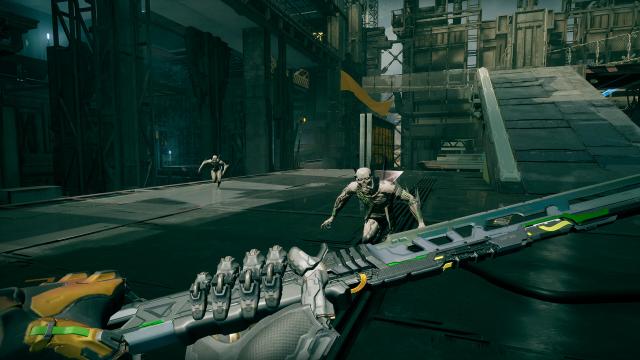
I firmly believe that innovation in gaming is not always a good thing; that some titles have such solid foundations that all they should seek to do is polish things up and iterate. Ghostrunner II is probably the strongest argument for that position yet; a sequel to a game that nailed so much that it really only needed a few minor tune ups. And while Ghostrunner II certainly does that, it also provides something I didn’t want: innovation for innovation’s sake. This drags the experience down. Instead of being a title that defines the generation – and perhaps even the medium – for me, Ghostrunner II has to settle for being ‘merely’ great. Hopefully a third entry in the series can strike a better balance between mixing things up and maintaining the well-refined gameplay as the centerpiece of attention.
You will probably like Ghostrunner II if: You enjoy fast-paced, quick reaction games and don’t mind adapting to a first person perspective.
You might like Ghostrunner II if: You were iffy on the original Ghostrunner but felt like some quality-of-life improvements could fix it.
You might not like Ghostrunner II if: Fast-paced action games aren’t your thing.
VGChartz Verdict
This review is based on a digital copy of Ghostrunner II for the PC
More Articles





